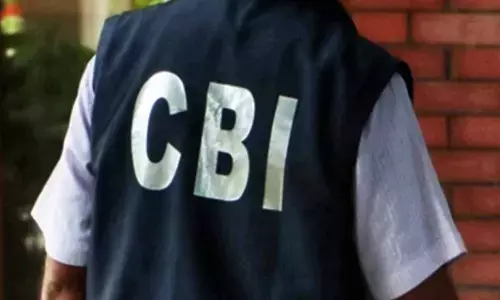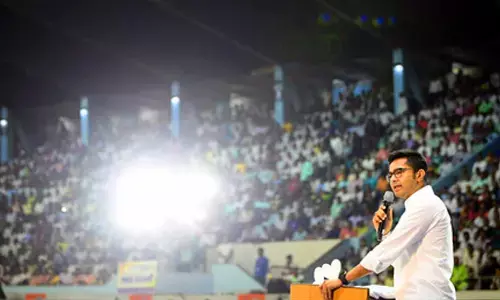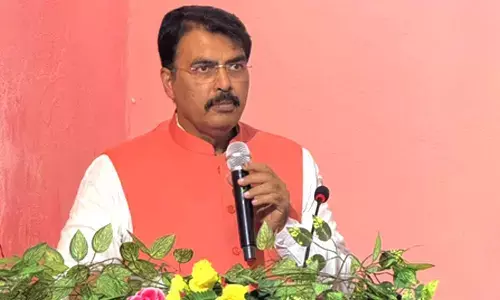Why govt schools being pushed to closure?

On April 12, the Supreme Court lamented that efforts were not being made to enroll children into public schools and viewed that every village should have a public school. The Court was hearing a petition that in Telangana and Andhra Pradesh accountability about schools was missing.
On April 12, the Supreme Court lamented that efforts were not being made to enroll children into public schools and viewed that every village should have a public school. The Court was hearing a petition that in Telangana and Andhra Pradesh accountability about schools was missing.
Govts giving up their role
Primary education is at cross roads and calls for a serious view and reiteration of state policies
- Govt's claim no or few students, hence the need to rationalise no. of schools
- But they gloss over shortage and standards, to facilities of teachers,
- Result: Parents, often poor, end up having to send children to private schools
- The high rate of children in private schools going for tuition also calls for concern
- Why the children of private schools to need to take to private tuition?
Justice Deepak Misra of Supreme Court called for a report within four weeks on why in 398 public schools, not a single child was enrolled during the current year. The allegation before the Court was that to close own public schools, no effort was made to fill in teacher vacancies and to enroll children with an excuse that private schools exist locally.
In the din of political controversies, two reminders recently in this regard about critical aspects of basic education in the country have lost public attention.
Is RTE Act being ignored?
Though the Right to Education Act envisages universal enrolment, reduced dropout and better teacher student ratio for good education, some State governments have been trying to close down some schools on the pretext that there are not enough children locally, instead of making efforts to muster enrollment. Fewer children in government schools do not mean that no children locally are going to schools.
First, there are children who are not going to any school. Secondly, children are shifted from local government school to private school or ferried to a private school in nearby town. This dilemma has been reported in Transparency Review more than twice in last two years.
Telangana state, for example, has announced closing down of 2000 government schools now. (Sakshi, April 4,2016) without any plan as to the schools to which these few students in schools being closed down are going to be admitted and how far away they are from homes and for what purpose the school building being closed down will be used.
In Haryana, a massive enrolment drive is being organised now by the government schools to stem the decline in the number of children admitted to public schools. Various methods are being used to persuade the parents and involve the panchyat in that drive. And the government is taking steps to address teacher vacancies (The Tribune, 8 April 2016).
Delhi State government has gone a step further not only to rejuvenate public schools but it is also regulating private schools to confine to various conditions as in the Right to Education Act. Even in Telangana and Andhra Pradesh some teachers of public schools are taking good initiatives on their own as I have personally seen in Khammam and Krishna districts.
But serious concern and initiatives of the government is not so evident. It is in this context the Supreme Court intervention makes sense.
The 71st round of National Sample Survey (January - July 2014) has brought out that 23.1 percent of boys and 20.2 percent of girls in elementary schools take to "private tuition."
In fact, a much higher percent in the case of boys and girls at higher secondary level take to private tuition irrespective of children are going to public or private schools.
Why did private school children take to private tuition?
What does this mean? Two things should be looked into. First, is this adding to standards in education and adding to the accomplishments of school children? Second, that 26 percent of all school going children take to private tuition indicate that both private and public schools are not up to the mark and that parents are not happy about.
That tuition fees in private school is high unlike in the case of public schools is known, but that such high percent of almost a quarter of those children in private schools pay additionally for private coaching is not so much known. Why these children of private schools too need to take to private tuition?
Pvt school education costly
NSS also indicated that on an average, government schools spend Rs 1,111 per child for primary level, but in the case of private schools, it works out to Rs 10,623. In fact, this expenditure per child at higher elementary school level is Rs 1,869 in public schools against Rs 13,808 in the case of private schools. Similarity, at high school level cost per child in private schools, works out to three times more.
In urban what is spent by primary and secondary schools is much higher than in rural. This cost in private schools is one of the factors for indebtedness of several families and also for dropout rate. There were a couple of instances of suicides by these students for not able to pay the tuition fees or and humiliation that they have to face for not able to pay the fees promptly (Eenadu, April 6, 2016).
Studies by Pratham in the last couple of years have been showing that children in seventh and eight class were not able to read or do maths of two levels below their class. But generally that blame is attributed to public schools where not only school fees is not there, teachers are trained, basic infrastructure is better. Even uniform and books are provided and mid-day meal is given in school itself.
The NSS finding did not prompt concern of elected representatives at any level nor of the Government, both of the Union and State. There hardly exist any mechanism to regulate tuition fees in private schools nor enforce standards outlined in the Right to Education Act. On the contrary, evidences are there of political leaders patronage or promoting private schools unconcerned of standards as their own children go to some other far away schools.
From these contradictions on ground, it is clear that our primary education is at cross roads and calls for a serious view and reiteration of state policies. Should state withdraw from its constitutional obligations and from primary responsibility to universal literacy and primary education cutting across socio-economic and demographic divides? There is a need for a public debate! (The writer is Chairman of CMS India)















